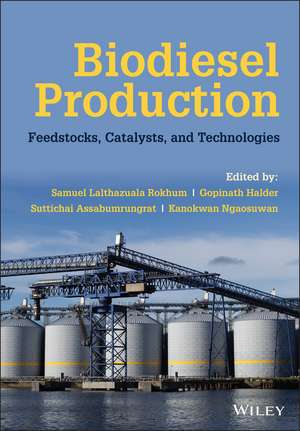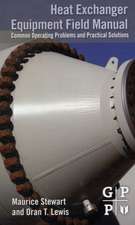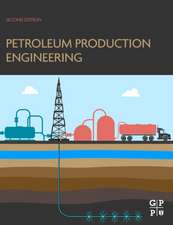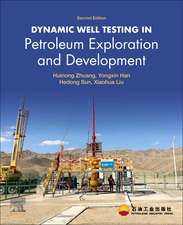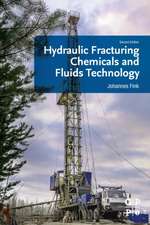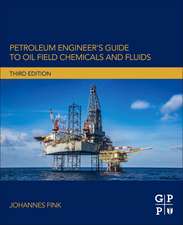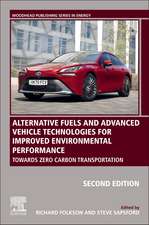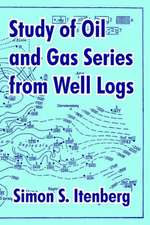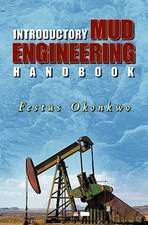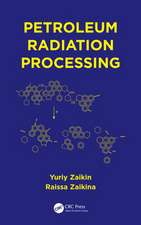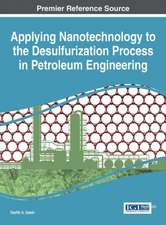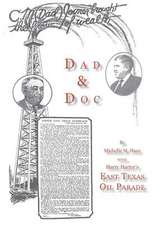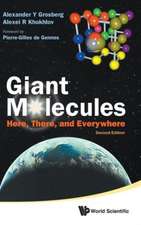Cuprins
Preface xv
List of Contributors xvii
An Overview of Biodiesel Production xxi
Part 1 Biodiesel Feedstocks 1
1 Advances in Production of Biodiesel from Vegetable Oils and Animal Fats 3
Umer Rashid and Balkis Hazmi
1.1 Introduction 3
1.2 History of the Use of Vegetable Oil in Biodiesel 6
1.3 Feedstocks for Biodiesel Production 6
1.3.1 Generations of Biodiesel 7
1.3.2 First-Generation Biodiesel 7
1.3.3 Second-Generation Biodiesel 8
1.3.4 Third-Generation Biodiesel 8
1.4 Basics of the Transesterification Reaction 8
1.5 Variables Affecting Transesterification Reaction 10
1.6 Alkaline-Catalyzed Transesterification 10
1.7 Acid-Catalyzed Transesterification 15
1.8 Enzymatic-Catalyzed Transesterification 16
1.9 Fuel Properties and Quality Specifications for Biodiesel 19
1.10 Conclusion 20
References 21
2 Green Technologies in Valorization of Waste Cooking Oil to Biodiesel 33
Bisheswar Karmakar and Gopinath Halder
2.1 Introduction 33
2.1.1 The Necessity for Biodiesel 33
2.1.2 Sourcing the Correct Precursor 33
2.2 Importance of Valorization 35
2.3 Purification and Characterization 35
2.4 Transesterification: A Comprehensive Look 36
2.5 Conversion Techniques 37
2.5.1 Traditional Conversion Approaches 38
2.5.1.1 Acid Catalysis 38
2.5.1.2 Alkali Catalysis 38
2.5.1.3 Enzyme Catalysis 40
2.5.1.4 Other Novel Heterogeneous Catalysts 40
2.5.1.5 Two-Step Catalyzed Process 41
2.5.2 Modern Conversion Approaches 41
2.5.2.1 Supercritical Fluids 41
2.5.2.2 Microwave Irradiation 43
2.5.2.3 Ultrasonication 43
2.6 Economics and Environmental Impact 44
2.7 Conclusion and Perspectives 45
References 45
3 Non-edible Oils for Biodiesel Production: State of the Art and Future
Perspectives 49
Valeria D'Ambrosio, Enrico Scelsi, and Carlo Pastore
3.1 Introduction 49
3.2 Vegetable Non-edible Oils 50
3.2.1 General Cultivation Data 50
3.2.2 Composition and Chemical-Physical Properties of Biodiesel Obtained from Non-edible Vegetable Oils 50
3.2.3 Biodiesel Production from Non-edible Vegetable Oil 54
3.2.3.1 Extraction Methods 54
3.2.3.2 Biodiesel Production 57
3.2.4 Criticisms Related to Non-edible Oils 57
3.3 Future Perspectives of Non-edible Oils: Oils from Waste 58
3.4 Conclusion 60
Acknowledgments 61
References 61
4 Algal Oil as a Low-Cost Feedstock for Biodiesel Production 67
Michael Van Lal Chhandama, Kumudini Belur Satyan, and Samuel Lalthazuala Rokhum
4.1 Introduction 67
4.1.1 Microalgae for Biodiesel Production 68
4.2 Lipid and Biosynthesis of Lipid in Microalgae 70
4.2.1 Lipid Biosynthesis 71
4.2.2 Lipid Extraction 72
4.3 Optimization of Lipid Production in Microalgae 73
4.3.1 Nitrogen Stress 73
4.3.2 Phosphorous Stress 73
4.3.3 pH Stress 74
4.3.4 Temperature Stress 74
4.3.5 Light 75
4.4 Conclusion 75
References 76
Part 2 Different Catalysts Used in Biodiesel Production 83
5 Homogeneous Catalysts Used in Biodiesel Production 85
Bidangshri Basumatary, Biswajit Nath, and Sanjay Basumatary
5.1 Introduction 85
5.2 Transesterification in Biodiesel Synthesis 86
5.3 Homogeneous Catalyst in Biodiesel Synthesis 88
5.3.1 Homogeneous Acid Catalyst 88
5.3.2 Homogeneous Base Catalyst 90
5.4 Properties of Biodiesel Produced by Homogeneous Acid and Base-Catalyzed Reactions 93
5.5 Relevance of Homogeneous Acid and Base Catalysts in Biodiesel Synthesis 96
5.6 Conclusion 96
References 97
6 Application of Metal Oxides Catalyst in Production of Biodiesel 103
Hui li
6.1 Basic Metal Oxide 103
6.1.1 Monobasic Metal Oxide 103
6.1.1.1 Alkaline Earth Metal Oxide 103
6.1.1.2 Transition Metal Oxide 105
6.1.2 Multibasic Metal Oxide 105
6.1.2.1 Supported on Metal Oxide 106
6.1.2.2 Supported on Activated Carbon 106
6.1.2.3 Supported on Metal Organic Framework 107
6.1.3 Active Site-Doped Basic Metal Oxide 107
6.1.3.1 Alkali Metal Doped 107
6.1.3.2 Active Metal Oxide Doped 107
6.1.4 Mechanism of Transesterification Catalyzed by Basic Metal Oxide 108
6.2 Acid Metal Oxide 108
6.2.1 Monoacid Metal Oxide 109
6.2.2 Multiacid Metal Oxide 109
6.2.3 Supported on Metal Organic Framework 112
6.2.4 Mechanism of Transesterification/Esterification Catalyzed by Acid Metal Oxide 112
6.3 Deactivation of Metal Oxide 113
References 114
7 Supported Metal/Metal Oxide Catalysts in Biodiesel Production 119
Pratibha Agrawal and Samuel Lalthazuala Rokhum
7.1 Introduction 119
7.2 Supported Catalyst 120
7.3 Metals and Metal Oxide Supported on Alumina 120
7.4 Metals and Metal Oxide Supported on Zeolite 123
7.5 Metals and Metal Oxide Supported on ZnO 125
7.6 Metals and Metal Oxide Supported on Silica 127
7.7 Metals and Metal Oxide Supported on Biochar 128
7.7.1 Solid Acid Catalysts 129
7.7.2 Solid Alkali Catalysts 129
7.8 Metals and Metal Oxide Supported on Metal Organic Frameworks 131
7.9 Metal/Metal Oxide Supported on Magnetic Nanoparticles 134
7.10 Summary 135
References 136
8 Mixed Metal Oxide Catalysts in Biodiesel Production 143
Brandon Lowe, Jabbar Gardy, Kejun Wu, and Ali Hassanpour
8.1 Introduction 143
8.2 Previous Research 144
8.3 State of the Art 150
8.3.1 Solid Acid MMO Catalysts 150
8.3.2 Solid Base MMO Catalysts 150
8.3.3 Solid Bifunctional MMO Catalysts 156
8.4 Discussion 157
8.5 Conclusion 161
8.6 Symbols and Nomenclature 162
References 162
9 Nanocatalysts in Biodiesel Production 167
Avinash P. Ingle, Rahul Bhagat, Mangesh P. Moharil, Samuel Lalthazuala Rokhum, Shreshtha Saxena, and S. R. Kalbande
9.1 Introduction 167
9.2 Transesterification of Vegetable Oils 169
9.3 Conventional Catalysts Used in Biodiesel Production: Advantages and Limitations 171
9.3.1 Homogeneous Catalysts 171
9.3.2 Heterogeneous Catalysts 172
9.3.3 Biocatalysts 173
9.4 Role of Nanotechnology in Biodiesel Production 173
9.5 Different Nanocatalysts in Biodiesel Production 173
9.5.1 Metal-Based Nanocatalysts 174
9.5.2 Carbon-Based Nanocatalysts 175
9.5.3 Zeolites/Nanozeolites 180
9.5.4 Magnetic Nanocatalysts 182
9.5.5 Nanoclays 184
9.5.6 Other Nanocatalysts 184
9.6 Conclusion 185
Acknowledgment 185
References 185
10 Sustainable Production of Biodiesel Using Ion-Exchange Resin Catalysts 193
Naomi Shibasaki-Kitakawa and Kousuke Hiromori
10.1 Introduction 193
10.2 Features of Ion-Exchange Resin Catalysts 194
10.3 Cation-Exchange Resin Catalyst 194
10.3.1 Notes of Caution When Comparing the Activity of Resins with Different Properties 194
10.3.2 Reversible Reduction of Resin Catalytic Activity by Water 196
10.3.3 Search for Operating Conditions for Maximum Productivity Rather than Maximum Catalytic Activity 198
10.3.4 Challenges Regarding One-Step Reaction with Simultaneous Esterification and Transesterification Catalyzed by Cation-Exchange Resin 198
10.4 Anion-Exchange Resin Catalysts 199
10.4.1 Requirements for High Catalytic Activity in the Transesterification of Triglycerides 199
10.4.2 Analysis of Previous Studies 201
10.4.3 Decreased Catalytic Activity and Regeneration Method 203
10.4.4 Additional Functions Unique to Anion-Exchange Resins 204
10.5 Summary 204
References 205
11 Advances in Bifunctional Solid Catalysts for Biodiesel Production 209
Bishwajit Changmai, Michael Van Lal Chhandama, Chhangte Vanlalveni, Andrew E.H. Wheatley, and Samuel Lalthazuala Rokhum
11.1 Introduction 209
11.2 Application of Solid Bifunctional Catalyst in Biodiesel Production 210
11.2.1 Acid-Base Bifunctional Catalysts 210
11.2.1.1 Oxides of Acid-Base 211
11.2.1.2 Acid-Base Hydrides 213
11.2.2 Bifunctional Acid Catalyst 217
11.2.2.1 Bifunctional Brønsted-Lewis Acid Oxides 217
11.2.2.2 Heteropolyacid-Based Bifunctional Catalyst 220
11.2.3 Biowaste-Derived Bifunctional Catalyst 222
11.3 Summary and Concluding Remarks 224
Acknowledgment 225
References 225
12 Application of Catalysts Derived from Renewable Resources in Production of Biodiesel 229
Kanokwan Ngaosuwan, Apiluck Eiad-ua, Atthapon Srifa, Worapon Kiatkittipong, Weerinda Appamana, Doonyapong Wongsawaeng, Armando T. Quitain, and Suttichai Assabumrungrat
12.1 Introduction 229
12.2 Potential Renewable Resources for Production of Biodiesel Catalysts 230
12.2.1 Animal Resources 230
12.2.1.1 Eggshells (Chicken and Ostrich) 231
12.2.1.2 Seashells (Snail, Mussel, Oyster, and Capiz) 231
12.2.1.3 Bones 233
12.2.2 Plant Resources 233
12.2.2.1 Carbon-Supported Catalysts 233
12.2.2.2 Silica-Supported Catalysts 236
12.2.2.3 Other Potential Elements from Plant Residues 236
12.2.3 Natural Resources 236
12.2.3.1 Dolomitic Rock (Calcined Dolomite and Modified Dolomite) 236
12.2.3.2 Lime 237
12.2.3.3 Natural Clays 237
12.2.3.4 Zeolites 238
12.2.4 Industrial Waste Resources 240
12.2.4.1 Food Industry Wastes 240
12.2.4.2 Mining Industry Wastes 240
12.3 Advantages, Disadvantages, and Challenges of These Types of Catalyst for Biodiesel Production 242
Acknowledgment 243
References 243
13 Biodiesel Production Using Ionic Liquid-Based Catalysts 249
B. Sangeetha and G. Baskar
13.1 Introduction 249
13.2 Mechanism of IL-Catalyzed Biodiesel Production 250
13.3 Acidic and Basic Ionic Liquids (AILs/BILs) as Catalyst in Biodiesel Production 250
13.4 Supported Ionic Liquids in Biodiesel Production 251
13.5 IL Lipase Cocatalysts 255
13.6 Optimization and Novel Biodiesel Production Technologies Using ILs 257
13.7 Recyclability of the Ionic Liquids on Biodiesel Production 259
13.7.1 Recovery of ILs 259
13.7.2 Reuse of Ionic Liquids 260
13.8 Kinetics of IL-Catalyzed Biodiesel Production 260
13.9 Techno-Economic Analysis and Environmental Impact Analysisof Biodiesel Production Using Ionic Liquid as Catalyst 261
13.10 Conclusion 262
References 263
14 Metal-Organic Frameworks (MOFs) as Versatile Catalysts for Biodiesel Synthesis 269
Vasudeva Rao Bakuru, Marilyn Esclance DMello, and Suresh Babu Kalidindi
14.1 Introduction 269
14.1.1 Metal-Containing Secondary Building Units 271
14.1.2 Organic Linker 272
14.1.3 Pore Volume 272
14.2 Biodiesel Synthesis Over MOF Catalysts 273
14.2.1 Transesterification Reaction 274
14.2.1.1 Transesterification at SBUs of MOFs 274
14.2.1.2 Transesterification at Linker Active Sites 276
14.2.2 Esterification of Carboxylic Acids 277
14.2.2.1 Esterification of Carboxylic Acids at SBUs of MOFs 277
14.2.2.2 Esterification of Carboxylic Acids at Linker Active Sites 279
14.2.2.3 Esterification at Pore Volume (Guest Incorporation) 280
14.3 Conclusion 281
References 281
Part 3 Technologies, By-product Valorization and Prospects of Biodiesel Production 285
15 Upstream Strategies (Waste Oil Feedstocks, Nonedible Oils, and Unicellular Oil Feedstocks like Microalgae) 287
Aleksandra Sander and Ana Petracic
15.1 Introduction 287
15.1.1 Classification of Biodiesel 287
15.1.2 Commercial Production of Biodiesel 288
15.2 Biodiesel Feedstocks 290
15.2.1 Edible Oils as Feedstock for Biodiesel Production 291
15.2.2 Nonedible Oils as Feedstocks for Biodiesel Production 292
15.2.3 Waste Feedstocks (Waste Cooking Oils, Waste Animal Fats, Waste Coffee Ground Oil, Olive Pomace) 292
15.2.4 Unicellular Oil Feedstocks (Microalgae, Yeasts, Cyanobacteria) 293
15.3 Composition of Oils and Fats 293
15.4 Methods for Oil Extraction 294
15.4.1 Mechanical Extraction 294
15.4.2 Solvent Extraction 295
15.4.3 Enzymatic Extraction 296
15.5 Purification of Oils and Fats 297
15.5.1 Deacidification 297
15.5.2 Winterization 298
15.5.3 Demetallization 298
15.5.4 Degumming 298
15.6 Production of Biodiesel 299
15.6.1 Catalysts for Biodiesel Production 300
15.6.2 Homogeneous Catalysts 300
15.6.3 Heterogeneous Catalysts 301
15.7 Future Prospects 302
References 302
16 Mainstream Strategies for Biodiesel Production 311
Narita Chanthon, Nattawat Petchsoongsakul, Kanokwan Ngaosuwan, Worapon Kiatkittipong, Doonyapong Wongsawaeng, Weerinda Appamana, and Suttichai Assabumrungrat
16.1 Introduction 311
16.2 Mainstream Strategies and Technology for Biodiesel Production 312
16.2.1 Current Mainstream Operation 312
16.2.1.1 Batch Mode 312
16.2.1.2 Continuous Mode 312
16.2.2 Process Mainstream for Biodiesel Production Based on the Reactor Types 313
16.2.2.1 Rotating Reactor 313
16.2.2.2 Tubular Flow Reactor 315
16.2.2.3 Cavitational Reactor 317
16.2.2.4 Microwave Reactor 318
16.2.2.5 Multifunctional Reactor (Reactive Distillation, Membrane, Centrifugal Reactors) 319
16.2.2.6 Other Process Intensification 322
16.3 Future Prospects and Challenges 323
Acknowledgment 327
References 327
17 Downstream Strategies for Separation, Washing, Purification, and Alcohol Recovery in Biodiesel Production 331
Ramón Piloto-Rodríguez and Yosvany Díaz-Domínguez
17.1 Introduction 331
17.1.1 Factors Affecting Biodiesel Yield 332
17.1.2 Transesterification Reaction Conditions 332
17.1.3 Separation After FAME Conversion 332
17.1.4 Washing 334
17.2 Glycerol Separation and Refining 336
17.3 Membrane Reactors 337
17.4 Methanol Recovery 339
17.5 Additization 339
17.6 Conclusion 342
References 343
18 Heterogeneous Catalytic Routes for Bio-glycerol-Based Acrylic Acid Synthesis 345
Nittan Singh, Pavan Narayan Kalbande, and Putla Sudarsanam
18.1 Introduction 345
18.2 Acrylic Acid Synthesis from Propylene 346
18.3 Acrylic Acid Synthesis from Glycerol 346
18.3.1 Glycerol Dehydration to Acrolein 347
18.3.2 Acrylic Acid Synthesis from Glycerol 349
18.4 Conclusion 351
Acknowledgments 353
References 353
19 Sustainability, Commercialization, and Future Prospects of Biodiesel Production 355
Pothiappan Vairaprakash, and Arumugam Arumugam
19.1 Introduction 355
19.2 Biodiesel as a Promising Renewable Energy Carrier 356
19.3 Overview of the Biodiesel Production Process 358
19.4 Evolution in the Feedstocks Used for the Sustainable Production of Biodiesel 359
19.5 First-Generation Biodiesel and the Challenges in Its Sustainability 359
19.6 Development of Second-Generation Biodiesel to Address the Sustainability 361
19.7 Algae-Based Biodiesel 362
19.8 Waste Oils, Grease, and Animal Fats in Biodiesel Production 363
19.9 Technical Impact by the Biodiesel Usage 363
19.10 Socioeconomic Impacts 364
19.11 Toxicological Impact 364
19.12 Sustainability Challenges in the Biodiesel Production and Use 365
19.13 Concluding Remarks 366
References 366
20 Advanced Practices in Biodiesel Production 377
Trinath Biswal, Krushna Prasad Shadangi, and Rupam Kataki
20.1 Introduction 377
20.2 Mechanism of Transesterification 378
20.3 Advanced Biodiesel Production Technologies 379
20.3.1 Production of Biodiesel Using Membrane Reactor 379
20.3.1.1 Principle 379
20.3.2 Microwave-Assisted Transesterification Technology 381
20.3.2.1 Principle 381
20.3.3 Ultrasonic-Assisted Transesterification Techniques 382
20.3.4 Production of Biodiesel Using Cosolvent Method 385
20.3.4.1 Principle 385
20.3.5 In Situ Biodiesel Production Technology 385
20.3.5.1 Principle 385
20.3.6 Production of Biodiesel Through Reactive Distillation Process 387
20.3.6.1 Principle 387
20.4 Conclusion 389
20.5 Future Perspectives 390
References 390
Index 397
Notă biografică
Samuel Lalthazuala Rokhum, PhD, is a Postdoctoral Fellow in the laboratory of Prof. Andrew EH Wheatley in the Department of Chemistry, Cambridge University, UK and Assistant Professor in the Department of Chemistry, National Institute of Technology in Silchar, India. His research interest includes organic chemistry, material chemistry, renewable energy, and heterogeneous catalysis. He is actively engaged in numerous scientific societies and currently served as an Academic Editor of Journal of Chemistry (Hindawi) and a guest editor in several journals. Gopinath Halder, Ph.D., is Professor in the Department of Chemical Engineering, National Institute of Technology Durgapur, India. As a chemical engineer, Prof. Halder has more than two decades of teaching and research experience in biofuel synthesis from non-edible and microalgal feedstock, preparation of heterogeneous carbonaceous catalyst, process optimization and bioremediation of contaminated waste water containing heavy metals, fluoride ions and pharmaceutical active compounds. Suttichai Assabumrungrat is Full Professor in Chemical Engineering, and the Director of Bio-Circular-Green economy Technology and Engineering Center (BCGeTEC), Faculty of Engineering at Chulalongkorn University, Bangkok, Thailand. His research interest includes applications of multifunctional reactors and process intensification for chemical, petrochemical and biorefinery industries. Particular focuses are on technologies related to production of biofuels, bio-based chemicals and hydrogen as well as CO2 capture and utilization. Kanokwan Ngaosuwan is Associate Professor in Chemical Engineering at the Division of Chemical Engineering, Rajamangala University of Technology Krungthep, Bangkok, Thailand. She earned her Ph.D. degree in chemical engineering from Chulalongkorn University, Thailand. Her research interests include biomass conversion, heterogenous catalysis and catalytic reaction engineering, and process intensification.
